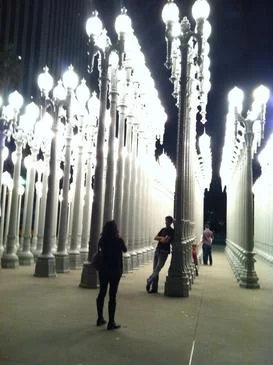What type of art was created during the Conceptualist movement?
Art, design, photography and even videos and installations were made in the Conceptualist art movement.
Conceptualism was created and popular during which years?
The Conceptualist art movement became popular from the mid-1960s to 1970s.
Where was Conceptualist art made and popularised?
Conceptualism began in America and spread to Europe. Eventually, the art movement spread across the globe.
Who are some famous Conceptualism artists and artworks?
Urban Light by Chris Burden
Hate and Power Can Be a Terrible Thing by Tracey Emin
Capri Battery by Joseph Beuys
Interesting observations about Conceptualism
For a painting to be called Conceptualist, every element on the canvas should be cohesive to each other and together be greater than the sum of its parts. This means that there is a greater focus on the meaning of the entire artwork. This is because the whole painting communicates a single concept. Elements and colours used in Conceptualist artworks are generally harmonious with each other as they have to work in unison to represent a single concept.
Which art movement(s) came before the Conceptualist art movement?
Minimalism and Suprematism came before the Conceptualist art movement.
Which art movement(s) came after the Conceptualist movement?
The Contemporary art movement came around the time of Conceptualism. However, both, Conceptualist and Contemporary art are popular even today.
Top 10 Conceptualist Artworks
Give If You Can – Take If You Have To by Jacek Tylicki (2008)
Art in the Spirit of Generosity

Jacek Tylicki’s “Give If You Can – Take If You Have To” is a conceptual piece that aims to replace a traditional idea of ownership and commerce. Created in 2008, the artwork consists of a wooden sign with a titular inscription. Participants could contribute or take as needed. Tylicki’s wanted to foster a sense of communal exchange, challenging the idea that art is a mere commodity. The piece reflects the artist’s belief in the power of generosity and sharing resources as a form of artistic expression.
Memorial for the Victims of N*zi Military Justice by Olaf Nicolai
A Subtle Commemoration

Olaf Nicolai’s “Memorial for the Victims of N*zi Military Justice” is a conceptual artwork that navigates the delicate terrain of painful memories. This piece reveals Nicolai’s nuanced approach, with the memorial comprising a simple X-shaped installation. Since there have been so many victims, some of whose names are forgotten, the “X” refers to the nameless victims and heroes. Conversely, this memorial can be dedicated to a particular victim too. Since there is no name, it can be dedicated to all victims and any particular victim simultaneously.
One and Three Chairs by Joseph Kosuth (1965)
The Essence of Language and Perception

Joseph Kosuth’s “One and Three Chairs” is a seminal work that explores the relationship between language, perception, and reality. Created in 1965, the piece comprises an actual chair, a photograph of that chair, and a text that defines the term “chair.” Kosuth aimed to highlight the conceptual nature of art by presenting multiple representations of the same object. “One and Three Chairs” challenges traditional notions of artistic creation, prompting viewers to question the role of language in shaping our understanding of visual art.
Insertions into Ideological Circuits: Coca-Cola Project by Cildo Meireles (1970)
Subverting Consumerism

Cildo Meireles’ “Insertions into Ideological Circuits: Coca-Cola Project” is a conceptual artwork that subverts the language of consumerism. This project highlights Meireles’ engagement with everyday objects, specifically Coca-Cola bottles. The artist inserted subversive messages into the labels of these bottles, challenging the subtle messaging of mass-produced commodities. For example, one of the bottles has the words “Yankees Go Home!” printed on it. Meireles’ project takes the strong messaging of global capitalism and injects distractions by highlighting alternate meanings in their messages.
Fountain by Marcel Duchamp (1917)
Rethinking the Notion of Art

Marcel Duchamp’s “Fountain” is a versatile conceptual artwork that challenges traditional notions of artistic creation. It is considered versatile because this installation can be considered Conceptualism, Dadaism and arguably even Modern art. Created in 1917, the piece consists of a urinal turned on its back and signed “R. Mutt.” Duchamp intended to question the role of the artist and the criteria for defining art. “Fountain” sparked debates about the nature of art and the authority of the artist, because an actual urinal was passed off as an art installation.
Urban Light by Chris Burden
Illuminating Public Spaces

Chris Burden’s “Urban Light” is a conceptual artwork that transforms public space into a mesmerising tableau. Burden was inspired by the idea of repurposing historical artefacts, collected and restored antique street lamps to create a monumental installation. The piece, located at the entrance of the Los Angeles County Museum of Art, engages the people with the juxtaposition of historical elements in a contemporary context. “Urban Light” is an embodiment of Burden’s vision to bring art into the public sphere, transforming everyday objects into symbols of illumination within the community.
Hate and Power Can Be a Terrible Thing by Tracey Emin
Personal Narratives as Art

Tracey Emin’s “Hate and Power Can Be a Terrible Thing” is a conceptual artwork that weaves personal narratives into the fabric of art. According to some reports, Emin simply took insults she heard in the surroundings and wove them into a patchwork piece. The patchwork tugs at themes like the animosity of a perpetrator and the vulnerability of a victim. “Hate and Power Can be a Terrible Thing” exemplifies the power of the personal narrative as a form of conceptual expression.
Capri Battery by Joseph Beuys
Objects as Vehicles of Thought

Joseph Beuys’ “Capri Battery” is a conceptual artwork that transforms an everyday object into a vessel for artistic expression. During a visit to Capri, Beuys placed a lemon atop a copper plate and connected it to a zinc rod, creating a simple battery. The piece serves as a metaphor for the transformative potential of simple thoughts and ideas. Beuys’ willingness to engage with commonplace items as carriers of artistic meaning challenges the conventional notion of what can constitute art.
Four Colours Four Words by Joseph Kosuth (1966)
The Interplay of Language and Visuals

Joseph Kosuth’s “Four Colours Four Words” is another conceptual masterpiece by the artist, emphasising both the link and the separation between language and visual cues. In doing so, the artwork highlights the duality of the comprehensive and the sensory interpretation by the brain. Created in 1966, the artwork features four framed canvases, each displaying a different colour alongside its corresponding name. “Four Colours Four Words” prompts viewers to consider the arbitrariness of language in describing the visual world and the deception of visuals in conveying messages.
Untitled (Perfect Lovers) by Felix Gonzalez-Torres
Poetic Minimalism in Conceptual Art

Felix Gonzalez-Torres’ “Untitled (Perfect Lovers)” is a poignant conceptual artwork that explores themes of love and loss. Gonzalez-Torres had a personal connection to the work, which consists of two identical wall clocks set to the same time. This was made in memory of his partner. As an embodiment of perfect lovers, the clocks symbolise the temporary nature of life and the eternal nature of love. Viewers can experience the conceptual poignancy of the work.
The conceptual art movement provides glimpses into the intellectual and philosophical landscapes of artists who dared to challenge the conventions of traditional art. From Duchamp’s provocative urinal to Emin’s confessional patchwork, each artwork serves as a catalyst for the movement. Conceptual art, with its emphasis on ideas over objects, continues to provoke, inspire, and redefine the boundaries of artistic expression.
*Images from Wiki Commons







0 Comments